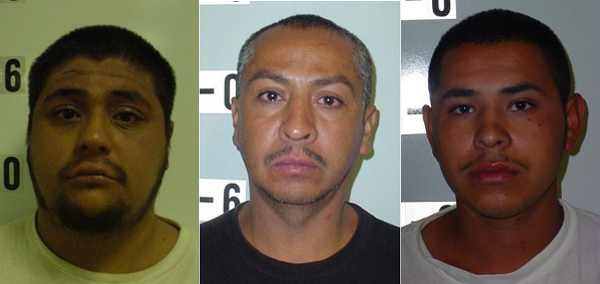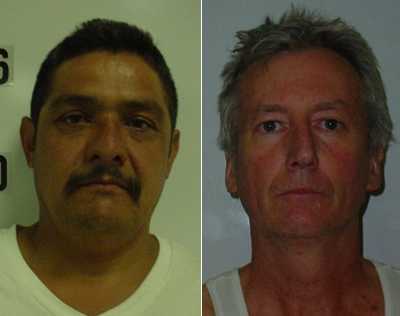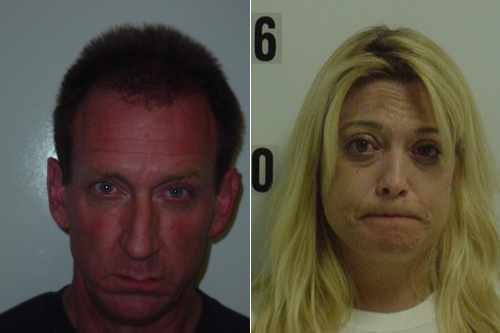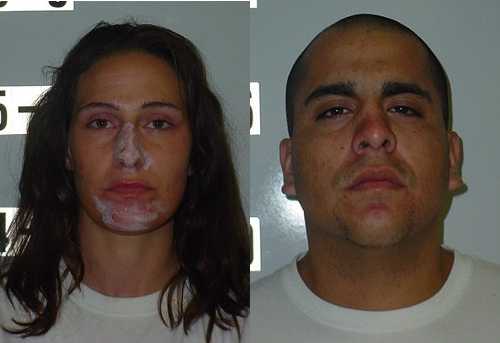LAKEPORT, Calif. – One of the two Clearlake Oaks men accused of shooting into a group of people at a Clearlake home in June 2011, killing a child and wounding five others, was in court on Thursday for closing arguments in his trial.
Orlando Joseph Lopez, 24, is on trial – along with 22-year-old Paul William Braden – for the June 18, 2011, murder of 4-year-old Skyler Rapp.
The shooting also wounded the child's mother, Desiree Kirby, as well as her boyfriend Ross Sparks and three other adults at the Lakeshore Drive home where Kirby and Sparks lived with their children.
Lopez and Braden have separate juries, and on Friday Braden and his attorney, Doug Rhoades, will present their arguments against District Attorney Don Anderson's case.
Both Lopez and Braden are facing 15 counts – including murder, attempted murder, mayhem and assault with a deadly weapon – and numerous special allegations for the shooting.
Lopez, wearing a dark suit, sat beside his attorney, Stephen Carter, taking copious notes throughout the day.
Visiting Yolo County Judge Doris Shockley – with the agreement from the jury to stay late to wrap up Lopez's arguments on Thursday – finished the day by reading jury instructions before handing the case over to the four-woman, eight-man jury, who will start deliberating Friday morning.
Four alternates – two men and two women – sat through the trial but will not deliberate unless they're needed to take the place of the main jurors.
Anderson spent much of the morning going over the counts against Lopez, as well as two legal theories under which he argued Lopez could be found guilty – being a direct shooter or aiding and abetting.
He dismissed what he said were “red herrings” introduced by the defense, including a DNA expert who said Lopez's DNA was not found on a shotgun located underneath the bed of former codefendant Kevin Stone, or on the .22 rifle Stone said he carried that night.
Anderson said there was no relevance to issued the defense raised regarding whether or not the Avenue Boyz, whose members were said to have been involved in a fight a week and a half before the shooting, were a criminal street gang.
“This case does not involve gangs,” said Anderson, who recalled testimony by Clearlake Police Det. Ryan Peterson, who stated the Avenue Boyz was not a validated criminal street gang.
Anderson also pointed out that the group's members testified to leaving a party at the home of Janet Leonor – where Braden and Lopez had been in the hours before the shooting – because they were concerned about Braden talking about shooting people.
A California Department of Justice ballistics expert testified during the trial that shotgun shells found at the crime scene and in a vehicle in which Stone allegedly had driven Braden and Lopez to Sparks' and Kirby's home had ejector marks resulting from racking a shotgun, Anderson said.
Witnesses claimed Braden had repeatedly racked a shotgun he had brought to the party at Leonor's home. He also had allegedly stated numerous times that he wanted to shoot someone.
A fingerprint expert said Braden's fingerprint was found on a hacksaw seized from Leonor's garage. There, using her hacksaw and workbench, Braden allegedly sawed off the butt of his shotgun and turned it into a pistol grip.
During Anderson's Thursday morning closing, Carter lodged several objections regarding misstatements of facts – including incorrectly attributing statements allegedly made by Lopez to Braden. Shockley reminded jurors that the attorneys' closing arguments were not evidence.
Anderson discussed texts that Lopez allegedly sent Ross Sparks, seeking to meet for a fight, as well as texts Lopez allegedly sent Stone telling him he had a robbery opportunity and a firearm.
The district attorney also addressed his plea agreement with Stone, who testified in the case in May. He is facing lesser charges and up to 10 years in prison.
“He pleaded to the crime that he committed, the crime that the District Attorney's Office can prove he committed,” said Anderson. “The evidence showed that he didn't do anything else.”
Raising objections
When Anderson later discussed statements allegedly made by Lopez he misspoke and said they were made by Braden, which caused Carter to object and request a hearing outside the jury's presence. Shockley sent the jury out briefly before asking the court reporter to read Anderson's statements back.
“It is misconduct to argue things that are not in evidence and that are not matters in common knowledge,” Carter said.
He said he was asking for an appropriate sanction, including mistrial, due to Anderson's misstatements.
“This is closing arguments in a homicide case by the prosecutor and the prosecutor must be held to the standards of prosecutorial ethics,” said Carter.
He added, “It's not a time to misspeak like that.”
Anderson admitted that he misspoke, and had meant to say Lopez, not Braden.
“I believe you when you tell me it was inadvertent. It happened once before,” said Shockley.
She said Carter's immediate objection had ensured that nothing about the alleged statements was disclosed and she would instruct the jury to disregard it. Shockley said it wasn't justification for mistrial.
However, she added, “This is very distressing and I would ask the prosecutor to be very careful in your arguments about who you're referring to.”
With the jurors back in their seats, Shockley informed them that Anderson had misspoke and reminded jurors that the attorneys' statements are not evidence.
Anderson, referring to statements attributed to Lopez, said Lopez told police that Braden was “sadistic,” that he thought Braden was playing and “I was afraid of him.”
He told the jury, “From all the evidence we believe this murder was intentional, deliberate and premeditated.”
He used a projector to display what he said was the content of the text messages that had been discussed in the trial.
Carter again objected, saying that one of the messages Anderson said was a text message actually was a phone discussion that didn't involve Lopez.
Shockley had Anderson take down the sheet on the projector, which she did again when Anderson posted another sheet that included a misstatement claiming that Stone had seen Lopez fire a shotgun.
As Anderson wrapped up for the morning, he told the jury, “The evidence will show that there were two shooters, not one.” He asked them to return a verdict of guilty on all counts.
Defense takes aim at evidence
When the jury reconvened after lunch it was Carter's turn to appeal to the jury, thanking members for their service.
With two separate juries, Carter reminded Lopez's jury that it wasn't their duty or burden to decide Braden's fate. Rather, they needed to consider if the government had proven if Lopez did anything.
Referring to Anderson's dual theory of either finding Lopez was a direct shooter or that he aided and abetted, Carter said, “I think the evidence shows that there is not enough to do either of those things.”
He discussed the Avenue Boyz, who he said sounded like a criminal street gang according to the evidence, and touched on a fight at an adult school graduation in early June 2011 that began the escalation of tensions which ultimately led to the fatal shooting.
Carter said no witness had put a gun in Lopez's hands until Stone reached a plea agreement with the District Attorney's Office. “And he's the only one who does it.”
He discussed the different accounts of how many gunshots were heard and how many muzzle flashes were seen, as well as the issues with some of the witness testimony.
He acknowledged that it was an emotional case, and can be upsetting, but that can't affect the jurors' verdict.
“It's not a question of whether it's sad. Of course it's sad. It's a question of what's been proven,” said Carter.
Carter questioned Stone's veracity, explaining that a jailhouse informant had stated that Stone told him he had fired his .22 rifle up in the air that night – consistent with what would be done in a robbery, Carter suggested – which conflicts with Stone's statement on the stand that he didn't fire at the scene. Stone also had allegedly admitted to the informant that he had picked up his spent cartridges before running away.
As for Lopez's intent, “There's ample evidence that it was not to shoot anybody,” Carter said.
But he suggested that it appeared well proven to him that Braden – not Lopez – killed Skyler Rapp. Carter said there was no evidence of Lopez discharging a firearm – not even from Stone, who he called the prosecution's “star witness.”
“You can't kill without shooting, and there's no evidence that he fired,” said Carter, adding that Lopez also didn't share the intent.
In a case where a lot of people got hurt and a child died, Carter said it's understandable to want to punish the the guilty person.
He said that convicting an innocent person would be on par with the tragedy of the child being gunned down.
“That is something that is up to you,” he told the jury, ending his comments just short of two hours.
Challenging the defense
Anderson, who got the final word in the day's arguments, worked to establish that Lopez was armed.
He said Avenue Boyz member Anthony Gaston testified to putting a shotgun on the porch of Leonor's home a few days before the shooting. On the night of the shooting, that shotgun was gone.
Anderson argued that Lopez went to the shooting scene “to do something” that included more than just a fist fight.
He said Stone's testimony has always been consistent and that the plea deal didn't affect his statements before the court.
“He doesn't please me, he has to testify to the truth,” said Anderson.
Anderson said Lopez told a police investigator that there were two shotguns at the incident, and Anderson maintained that the evidence proved there were two shooters.
If Lopez was going to a fist fight, Anderson questioned why he was giving shotgun shells to Braden, who had claimed that he wanted to kill someone. He said Lopez stuck with Braden that whole evening, going to get guns together and leaving with Stone to go to Sparks' home.
On one key point Anderson said he agreed with Carter.
“This was a tragic incident,” which resulted in a 4-year-old child's death and harm to others, he said.
From the first moment he took the case Anderson said he wondered, “What is the motive? Why did this occur?”
He said someone who was described as sadistic – Braden – was angry, and the shooting resulted.
Anderson asked the jury to convict Lopez.
Court resumes at 9 a.m. Friday, when Braden's jury will hear the closing arguments in his case.
Email Elizabeth Larson at This email address is being protected from spambots. You need JavaScript enabled to view it. .












